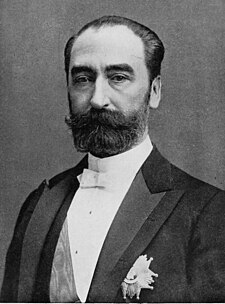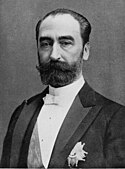Marie François Sadi Carnot
| Marie François Sadi Carnot | |
|---|---|
 | |
| 5. prezident Francie | |
| Ve funkci: 3. prosince 1887 – 25. června 1894 | |
| Předchůdce | Jules Grévy |
| Nástupce | Jean Casimir-Perier |
| Stranická příslušnost | |
| Členství | Republikánská levice |
| Narození | 11. srpna 1837 Limoges |
| Úmrtí | 25. června 1894 (ve věku 56 let) Lyon |
| Místo pohřbení | Pantheon (48°50′46″ s. š., 2°20′46″ v. d.) |
| Choť | Cécile Carnot |
| Rodiče | I. Carnot |
| Děti | Lazare-Hippolyte-Sadi Carnot Ernest Carnot François Carnot |
| Příbuzní | Marie-Adolphe Carnot (sourozenec) |
| Alma mater | Condorcetovo lyceum École polytechnique Národní škola silniční správy |
| Profese | politik, stavební inženýr, inženýr a úředník |
| Ocenění | rytíř Řádu slona (1891) velkokříž Řádu nizozemského lva (1892) Řád annámského draka Královský řád Kambodže Řád sv. Ondřeje … více na Wikidatech |
| Commons | Sadi Carnot (statesman) |
| Některá data mohou pocházet z datové položky. | |

Marie François Sadi Carnot, běžně jen Sadi Carnot (11. srpen 1837, Limoges – 25. červen 1894, Lyon), byl francouzský politik. Svou kariéru zakončil jako prezident Francouzské republiky. Byl zavražděn italským anarchistou Jeronimem Caseriou při výkonu funkce jen několik měsíců před vypršením mandátu.
Život a politická kariéra
Jeho otcem byl radikální republikánský poslanec Hippolyte Carnot, odpůrce Napoleona III.. Jeho strýc Nicolas Léonard Sadi Carnot byl fyzik, objevitel Carnotova cyklu. Mladý Sadi Carnot vystudoval pařížskou École polytechnique a pracoval jako projektant. Jeho jméno dosud nese Pont Carnot, most přes Rhônu v Savojsku. Podílel se také na regulaci řeky Thiou v Annecy. Za prusko-francouzské války organizoval obranu Normandie, po válce získal funkci prefekta v Seine-Inférieure a byl zvolen poslancem za umírněné republikány. Roku 1880 se stal ministrem veřejných prací a roku 1885 ministrem financí.
V roce 1887 byl prezident Jules Grévy donucen odstoupit, protože udělil Řád čestné legie svému zeti, aniž by si ho dotyčný něčím zasloužil. Poté parlament zvolil 3. prosince 1887 prezidentem Sadiho Carnota. Za jeho funkčního období proběhla úspěšná Světová výstava 1889, byla podepsána spojenecká smlouva s Ruskem, podařilo se potlačit hnutí generála Boulangera a Panamská aféra vedla k pádu Loubetovy vlády. Dobovým fenoménem byly bombové útoky anarchistů, které vedly v prosinci 1893 k přijetí Lois scélérates, zákonů omezujících některé občanské svobody.
Sadi Carnot vystoupil 24. června 1894 na shromáždění v lyonském Palais de la Bourse u příležitosti tamní koloniální výstavy, kde mimo jiné prohlásil, že po vypršení svého funkčního období nebude usilovat o znovuzvolení. Po deváté hodině večer při odchodu z budovy k prezidentovi přistoupil pekař italského původu Santo Geronimo Caserio a několikrát ho bodl nožem. Sadi Carnot v časných ranních hodinách následujícího dne svým zraněním podlehl. Caserio svůj čin vysvětlil jako pomstu za to, že prezident nařídil popravit anarchisty Augusta Vaillanta a Émila Henryho. Caserio byl odsouzen k trestu smrti gilotinou, reakcí na atentát byly četné násilné útoky na italské přistěhovalce na mnoha místech Francie. Sadi Carnot byl pohřben v pařížském Pantheonu, roku 1897 byl v Angoulême odhalen jeho pomník.
Externí odkazy
 Obrázky, zvuky či videa k tématu Marie François Sadi Carnot na Wikimedia Commons
Obrázky, zvuky či videa k tématu Marie François Sadi Carnot na Wikimedia Commons - https://web.archive.org/web/20150905124351/http://www.elysee.fr/la-presidence/marie-francois-sadi-carnot/
- http://www.larousse.fr/encyclopedie/personnage/Marie_Fran%C3%A7ois_Sadi_Carnot/111813
- http://www.rozhlas.cz/brno/avizoprog/_zprava/ecce-homo-marie-franois-sadi-carnot--122528
Média použitá na této stránce
Autor: JLPC, Licence: CC BY-SA 3.0
Monumental statue (1897), by Raoul Verlet, tribute to assassinated president Sadi Carnot, Angoulême, Charente, France.
Autor: Internet Archive Book Images, Licence: No restrictions
Identifier: evolutionoffranc00coub (find matches)
Title: The evolution of France under the third republic
Year: 1897 (1890s)
Authors: Coubertin, Pierre de, 1863-1937 Hapgood, Isabel Florence, 1850-1928. tr
Subjects:
Publisher: New York (etc.) T. Y. Crowell and company
Contributing Library: Robarts - University of Toronto
Digitizing Sponsor: University of Toronto
View Book Page: Book Viewer
About This Book: Catalog Entry
View All Images: All Images From Book
Click here to view book online to see this illustration in context in a browseable online version of this book.
Text Appearing Before Image:
not in its details, remainedabove party, where Gambetta had raised it aloft onthat first day, in the place where nations deposit theirarks of the covenant. With still greater wisdom, those who governed sup-pressed the anti-republican remarks which escaped thegenerals between two manoeuvres. The ministers andthe head of the State himself contented themselveswith the rather curt and sometimes rather disdainfulsalutes which they received from the military authori-ties. For a long time the name of the Republic wasomitted from the formal addresses and the orders ofthe day ; certain radical newspapers waxed indignantover this, and raised a cry of treason; in high placesconfident serenity was maintained. It was known thatthe lawyers and men of humble extraction, raised to thehighest posts in the State, often by talent, but some-times, also, by luck, must lack prestige with the gen-erals ; nevertheless, no one doubted the absolute devotionand patriotism of the latter. The day came when Presi-
Text Appearing After Image:
M. SADI-CARNOT, FOURTH PRESIDENT OF THE REPUBLIC. TEE NATION ARMED. 359 dent Carnot, at the end of the grand manoeuvres, couldreview the troops, and when the enthusiastic crowdhailed him with acclamations. The higher officersgrouped themselves about him, touched, at last, bythe enlightened solicitude, the unalterable confidenceshown by the Republic to its soldiers; and when theRepublic gave the French army the Russian army asits sister, their hearts were won; they forgot that thecommander-in-chief was a civilian ; moreover, destinyhad in store for him, as recompense, the death of asoldier. During the five-and-twenty years that France haslived in a state of armed peace, her regiments havebeen renewed sufficiently often to permit of ones mak-ing an attempt to form a general judgment as to theresults attained; results numerous and sufficiently un-expected, on one point, at least. Three classes of citi-zens have passed under the flags, — peasants, working-men, and men of the middle clas
Note About Images
Autor: Dessiné par Jérôme BLUM le 5 septembre 2007. Készítette: Jérôme BLUM 2007., Licence: CC BY-SA 2.0 fr
unofficial emblem of the French Republic, created from France coa.png. The only official emblem of France is its tricolour flag.


